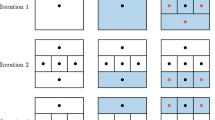Abstract
The concept of a filled function is introduced. We construct a particular filled function and analyze its properties. An algorithm for global minimization is generated based on the concept and properties of the filled function. Some typical examples with 1 to 10 variables are tested and computational results show that in most cases this algorithm works better than the tunneling algorithm. The advantages and disadvantages are analyzed and further research directions are discussed.
Similar content being viewed by others
References
F. Archetti and B. Betro, “A priori analysis of deterministic strategies for global optimization,” in: L.C.W. Dixon and G.P. Szegö, eds.,Towards Global Optimization, Vol. 2 (North-Holland, Amsterdam, 1978) pp. 31–48.
E.M.L. Beale and J.J.H. Forrest, “Global optimization as an extension of integer programming,” in: L.C.W. Dixon and G.P. Szegö, eds.,Towards Global Optimization, Vol. 2 (North-Holland, Amsterdam, 1978) pp. 131–149.
F.H. Branin, “Solution of nonlinear DC network problem via differential equations,” in:International IEEE Conference on System Network & Computers (Oaxtepex, Mexico, 1971).
F.H. Branin and S.K. Hoo, “A method for finding multiple extrema of a function ofn variables,” in: F. Lootsma, ed.,Numerical Methods of Nonlinear Optimization (Academic Press, New York, 1972) pp. 231–238.
L.C.W. Dixon, J. Gomulka and S.E. Herson, “Reflections on global optimization problem,” in: L.C.W. Dixon, ed.,Optimization in Action (Academic Press, New York, 1976) pp. 398–435.
L.C.W. Dixon, J. Gomulka and G.P. Szegö, “Towards global optimization technique,” in: L.C.W. Dixon and G.P. Szegö, eds.,Towards Global Optimization (North-Holland, Amsterdam, 1975) pp. 29–54.
A.A. Goldstein and J.F. Price, “On descent from a local minimum,”Mathematics of Computation 25 (1977) 569–574.
J. Gomulka, “Deterministic VS probabilistic approach to global optimization,” in: L.C.W. Dixon and G.P. Szegö, eds.,Towards Global Optimization Vol. 2, (North-Holland, Amsterdam, 1978) pp. 19–29.
A.L. Levy, “The tunneling algorithm for the global minimization of functions,” presented at:The Dundee biennial Conference on Numerical Analysis (Dundee, Scotland, 1977).
W.L. Price, “A controlled random search procedure for global optimization,” in: L.C.W. Dixon and G.P. Szegö, eds.,Towards Global Optimization, Vol. 2 (North-Holland, Amsterdam, 1978) pp. 71–84.
B.O. Shubert, “A sequential method seeking the global minimum of a function,”SIAM Journal Numerical Analysis 9 (3) (1972) 379–388.
G. Trecanni, “A global descent optimization strategy,” in: L.C.W. Dixon and G.P. Szegö, eds.,Towards Global Optimization, Vol. 2 (North-Holland, Amsterdam, 1978) pp. 165–177.
Author information
Authors and Affiliations
Rights and permissions
About this article
Cite this article
Renpu, G. A filled function method for finding a global minimizer of a function of several variables. Mathematical Programming 46, 191–204 (1990). https://doi.org/10.1007/BF01585737
Received:
Revised:
Issue Date:
DOI: https://doi.org/10.1007/BF01585737




